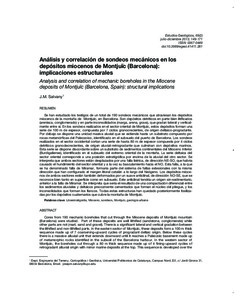Mostra el registre d'ítem simple
Análisis y correlación de sondeos mecánicos en los depósitos miocenos de Montjuïc (Barcelona): implicaciones estructurales
| dc.contributor.author | Salvany Duran, Josep Maria |
| dc.contributor.other | Universitat Politècnica de Catalunya. Departament d'Enginyeria del Terreny, Cartogràfica i Geofísica |
| dc.date.accessioned | 2014-02-06T14:14:14Z |
| dc.date.available | 2014-02-06T14:14:14Z |
| dc.date.created | 2013-07 |
| dc.date.issued | 2013-07 |
| dc.identifier.citation | Salvany, J. M. Análisis y correlación de sondeos mecánicos en los depósitos miocenos de Montjuïc (Barcelona): implicaciones estructurales. "Estudios geologicos (Madrid)", Juliol 2013, vol. 69, núm. 2, p. 149-171. |
| dc.identifier.issn | 0367-0449 |
| dc.identifier.uri | http://hdl.handle.net/2117/21472 |
| dc.description.abstract | Cores from 190 mechanic boreholes that cut through the Miocene deposits of Montjuïc mountain (Barcelona) were studied. Part of these deposits are well lithified (sandstone, conglomerate) while other parts are not (marl, sand and gravel). There is a significant lateral and vertical gradation between the lithified and non-lithified parts. In the eastern sector of Montjuïc, these deposits form a 100 m thick sequence made up of 7 coarsening-upward cycles of progradant deltaic origin. Below these cycles there is a massive alluvial unit that extends downward until it reaches a Paleozoic basement made up of metamorphic rocks identified in the subsoil of the Barcelona harbour. In the western sector of Montjuïc, the boreholes cut through a 80 m thick sequence made up of 4 fining-upward cycles of retrogradant alluvial origin with minor marine deposits at the top. This sequence is developed over the continental deposits of the Early Miocene (Burdigalian) found in the subsoil of the western edge of Montjuïc. The deltaic sequence of the eastern sector corresponds to a higher stratigraphic position than the alluvial sequence of the western sector. Both sectors are bounded by a listric fault of NE-SO strike, which may have caused the sinking of the eastern sector and its tilting toward the NW. This fault would be related to the extensional fault system that formed the coastal Catalan margin during the Neogene period. The entire Miocene unit of Montjuïc was also folded and form a gentle anticline of NO-SE strike. This fold would have originated before the faulting and can be interpreted as a syn-sedimentary structure originated by a differential compaction between the early cemented alluvial and deltaic sediments that form the fold core and the unconsolidated sediments that form its limbs. Both the anticline and the fault were subsequently unconformably covered by the Quaternary deposits that cover the mountain of Montjuïc. |
| dc.format.extent | 23 p. |
| dc.language.iso | spa |
| dc.rights | Attribution-NonCommercial 3.0 Spain |
| dc.rights.uri | http://creativecommons.org/licenses/by-nc/3.0/es/ |
| dc.subject | Àrees temàtiques de la UPC::Enginyeria civil::Geologia |
| dc.subject.lcsh | Montjuich (Barcelona, Spain) |
| dc.subject.lcsh | Geology, Stratigraphic--Miocene |
| dc.subject.other | Litoestratigrafía |
| dc.subject.other | Mioceno |
| dc.subject.other | Montjuïc |
| dc.subject.other | geología urbana |
| dc.title | Análisis y correlación de sondeos mecánicos en los depósitos miocenos de Montjuïc (Barcelona): implicaciones estructurales |
| dc.type | Article |
| dc.subject.lemac | Montjuïc (Barcelona, Catalunya) |
| dc.subject.lemac | Geologia estratigràfica |
| dc.identifier.doi | 10.3989/egeol.41411.281 |
| dc.relation.publisherversion | http://estudiosgeol.revistas.csic.es/index.php/estudiosgeol/article/view/890 |
| dc.rights.access | Open Access |
| local.identifier.drac | 13021364 |
| dc.description.version | Postprint (published version) |
| local.citation.author | Salvany, J. M. |
| local.citation.publicationName | Estudios geologicos (Madrid) |
| local.citation.volume | 69 |
| local.citation.number | 2 |
| local.citation.startingPage | 149 |
| local.citation.endingPage | 171 |
Fitxers d'aquest items
Aquest ítem apareix a les col·leccions següents
-
Articles de revista [239]


